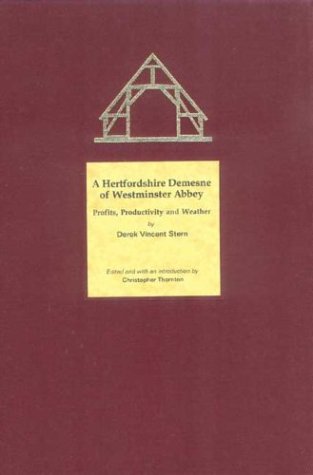Regional & Local History S.
1 total work
v. 1
This posthumous publication offers a contribution to the study of agricultural productivity and farming profits in medieval England. It utilizes a series of manorial account rolls from Westminster Abbey's manor of Kinsbourne in Hertfordshire, near the town of Harpenden, to conduct an exploration of the economic history of a medieval demesne. The book assesses the inter-relationships between all variables that may have affected yields and profits at Kinsbourne from the late-13th century through to the late-14th century. At its core lies a systematic breakdown of the Kinsbourne's demesne economy into its component parts, allowing observation of the separate incomes derived from corn, livestock and wool, for example, as well as the impact of both capital and labour costs. It, therefore, should provide a more detailed perspective upon medieval farming than the more common studies of large estates and regions. The quantity of agricultural information supplied in many tables, graphs and appendices, should make this a resource of comparative material for medieval economic historians.
One contentious factor studied of interdisciplinary interest, is the long-term impact of climatic change upon farming performance. The author used both direct references to the weather and "proxy" clues to meteorological conditions, such as the dates of agricultural operations (ploughing, sowing, harvesting) to build up a detailed picture of seasonal climate in the locality. His discussion shows how far Kinsbourne's physical output was determined by natural circumstances, as opposed to market forces or managerial policy. Analysis of farming success at Kinsbourne is based upon a comparison of profitability between two periods, first the period 1286-1307 at the height of direct management, and second, the period 1362-1397 which led up to the eventual decision to lease the Kinsbourne demesne. It is argued that the performance in the early-14th century was due to the cultivation of poor land, slack supervision, and unfavourable meteorological conditions. The contraction of the arable after the Black Death, and a strong administration resulted in improved profits, a finding which may indicate that the earlier period was one of hardship rather than prosperity for the manorial landowner.
The demesne's final demise is explained by referring to the fall in prices after 1375, and by suggesting that difficulties were experienced in securing labour.
One contentious factor studied of interdisciplinary interest, is the long-term impact of climatic change upon farming performance. The author used both direct references to the weather and "proxy" clues to meteorological conditions, such as the dates of agricultural operations (ploughing, sowing, harvesting) to build up a detailed picture of seasonal climate in the locality. His discussion shows how far Kinsbourne's physical output was determined by natural circumstances, as opposed to market forces or managerial policy. Analysis of farming success at Kinsbourne is based upon a comparison of profitability between two periods, first the period 1286-1307 at the height of direct management, and second, the period 1362-1397 which led up to the eventual decision to lease the Kinsbourne demesne. It is argued that the performance in the early-14th century was due to the cultivation of poor land, slack supervision, and unfavourable meteorological conditions. The contraction of the arable after the Black Death, and a strong administration resulted in improved profits, a finding which may indicate that the earlier period was one of hardship rather than prosperity for the manorial landowner.
The demesne's final demise is explained by referring to the fall in prices after 1375, and by suggesting that difficulties were experienced in securing labour.
